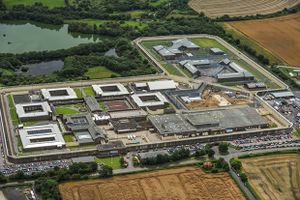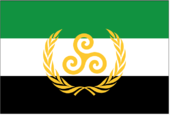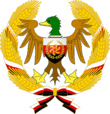Kingdom of Sorrenia
This article refers to a micronation or element of micronationalism which is defunct and no longer exists. You can help make the article reflect that or ask on the talk page for further information. |
Kingdom of Sorrenia (English) Tiarnas Sorrenya (Cumbric) Teyrnas Sorrenia (Welsh) Næluŕtoomerp ul Sorrenia (Mezerizeb) | |||||||||
|---|---|---|---|---|---|---|---|---|---|
| Motto: The North Stands Proud | |||||||||
| Anthem: Highland Cathedral | |||||||||
| Northern England | |||||||||
| Capital | Durham | ||||||||
| Largest city | Leeds | ||||||||
| Official languages | English (British English, Northumbrian dialects) and Cumbric Various regional languages | ||||||||
| Demonym(s) | Sorrenian | ||||||||
| Government | Unitary Constitutional Monarchy | ||||||||
• King | Ronald I | ||||||||
• Prime Minister | Llewelyn Lawton | ||||||||
| Legislature | King's Council | ||||||||
| Establishment | 04/04/18 | ||||||||
| Population | |||||||||
• Census | 4.95mn (estimate) | ||||||||
| Currency | Sorrenian Rosmerta Pound Sterling | ||||||||
| Time zone | Sorrenian Standard Time | ||||||||
Website Map of Sorrenia | |||||||||
| |||||||||
The Kingdom of Sorrenia (Cumbric: Tiarnas Sorrenya), also occasionally known as the New Kingdom of Northumbria was a micronation claiming sovereignty over all of Northern England. Founded in 2013 as the Sorrenian Federation, the Kingdom claimed almost 29,000 km2 of land which was divided into nineteen counties. The entirety of Sorrenia's claim was located in Great Britain, and constituted one contiguous mass.
Etymology
The name "Sorrenia" is an adaptation of "Sorrento", a small town in southern Italy, near Naples.
History
Kozlova
Sorrenia's direct predecessor was the Democratic People's Republic of Kozlova, founded in June 2012. The idea of micronationalism was first introduced to the founders of Sorrenia by Rilgar Ompastre, a friend from school who had earlier founded Dalton, which later became Dradelia.
Martin Aquinas, Dominik of Kozlova, and Lewis Wild were enthused by the idea, and founded Kozlova together. Intended to be a communist nation, Kozlova was nevertheless generally dismissive of soviet-style politics, and open to multi-party elections.
Kozlova saw an immediate burst of activity, and reached a population of ten citizens. By the end of 2012 however, Kozlova had entered into a period of inactivity. This was exacerbated when Lewis Wild left, founding Yavaria; Dominik followed suit, leaving micronationalism altogether. Kozlova entered into a period of dormancy, while several ex-Kozlovans took the opportunity to secede, founding anti-Kozlovan micronations.
By the summer of 2013, the remaining Kozlovan rump state entered into negotiations with the rebel micronations, who collectively agreed to disband their micronations and form a new one. This new micronation, named Sorrenia, was to retain an egalitarian and multi-party ethos, while abandoning references to communism. The Sorrenian Federation was officially created in November 2013.
Sorrenian Federation
War of the Sorrenian Succession

Gold: New Monarchists victory
Red: Socialist League victory
Blue: Dradelian victory
Brown: Morgannwgydd victory
Grey: Inconclusive result
After several years of hiatus, a group of leftists located in Bowburn and Sherburn formed the Socialist League, with the explicit intention of overthrowing the State of Sorrenia and reforming the Federation. Adam Scargill emerged as a leader of the League, with Harold Wanton leading the Sherburn contingent. Only a small number of the League however had participated in the Sorrenian Federation, and most were new to micronationalism altogether.
The League saw great success, first pushing State troops from southern Sorrenia, after which they attacked Durham, seizing the historic capital of Levaria. As the League saw successes in the south and east however, a disparate number of groups began to organise in the north and west; fearful of a return to socialism, conservatives, monarchists, and centrists coalesced around Ronald I, who hoped to establish a new monarchy in Sorrenia.
The two groups first met each other in Bernicia, where they fought over a store of armaments. Led by Michael Disraeli and Phillip Pompeia, the Royal Army defeated the socialists, securing a major victory.
Just two days after the League took it, they lost Levaria and Durham to the monarchists. In response, Scargill and Wanton established a siege from the south and west. After hours of combat, the socialists were pushed all the way back to their stronghold of Bowburn. Scargill announced a general rout, hoping to retreat to the east and reform; Wanton however secretly negotiated an amnesty deal with the royalists, and the Sherburn contingent of the League surrendered.
Scargill and the remnants of the League retreated to Horden, where they were beset upon by the Dradelian National Army. Close to defeat, the Socialists were ironically saved by an invasion of Dradelia by the Sorrenian Royal Army. The DNA turned to face the royalists to the north, but were soundly defeated, resulting in the incorporation of Dradelia once again into Sorrenia.
In response, the Kingdom of Morgannwg launched a surprise attack on Sorrenia from the south, seizing Bowburn and Ertawa. The Royal Army speedily departed to Ertawa, where they met Morgannwgydd forces in Brancepeth, once again securing a victory. The Morgannwgydd defeat at Brancepeth, followed up by a defeat in Eryn Galen, led to the incorporation of Morgannwg (renamed Amon Lasgalen) into Sorrenia.
On the fourth of April, 2018, Ronald I announced a complete and total victory, and was crowned King of Sorrenia and Dradelia, Amon Lasgalen, Morgannwg, and Duke of Creton, birthing the Kingdom of Sorrenia.
The War of the Sorrenian Succession had a lasting impact on Sorrenia. Ronald's successes allowed him to create a powerful monarchy with many executive and legislative powers, far beyond what the moderates within his coalition intended. Many leading Sorrenian politicians, such as Harold Wanton, Michael Disraeli, Phillip Pompeia, Llewelyn Lawton, and others, took part in the War, and engrained political divisions emerged from the dissatisfaction of the socialists and Dradelian nationalists with the result.
Foundations and the Great Expansion
The Kingdom's early period was marked by the construction of a new Sorrenian Constitution, attempts to address continued insurgency in Dradelia, and early elections for the King's Council. Though it was clear King Ronald was to play some political role, his coalition that won the War of Succession contained many moderates and centrists who envisaged a constitutional monarchy with strict limitations on the king's power. Others, including Ronald himself, wished to vest most executive power within the King himself.
The April 2018 election resulted in a New Monarchist-Old Monarchist coalition government, happy to formalise a system granting Ronald a wide array of powers. For the first month however, power arrangements were largely ad hoc, with few institutions' rules adequately laid out. It was not until the 5th of June that the new constitution was ratified.
The new constitution was controversial on two counts. Firstly, it angered many centrists and moderates by granting the monarch significant executive and legislative powers. King Ronald was given the power to raise and alter taxes, seize private goods, act as a supreme adjudicator in legal matters, create and disband subsidiary organisations, and veto decisions made by the newly created Papal Directorate (the King also received a permanent seat in Sorrenia's unicameral legislature). This Directorate was the second controversy; Ronald took the decision to designate Roman Catholicism as the new state religion of Sorrenia, despite the nation's history of secularism and large population of Anglicans and non-believers. An ecclesiastical court named the Papal Directorate was established, with the power to implement new policies related to social and moral matters. The constitution caused most moderates to abandon the New Monarchists, most of whom joined the NDLP.
By the June 2018 election, Richard Brooker - head of the Old Monarchists - began to envisage a massive extension in Sorrenia's territorial claim, matched with a reimagination of the Sorrenian project altogether. Brooker is generally attributed with the introduction of Northumbrianism into Sorrenian politics, a school of cultural theory emphasising the distinct history of northern England and Sorrenia's connection to this unique history and culture.
Brooker introduced his idea through a number of conversations with the king, who was quickly convinced. Together they formed the Cuthbert Council, consisting also of Michael Disraeli, Peter Otterson, Mark Rawlton and eventually Republican leader Martin Aquinas. Concerned that the immediate publication of their ideas would lead to outright dismissal, the Council collaborated to introduce the ideas into their respective parties.
After the June election, Brooker introduced their plans to the King's Council; the proposal was controversial, with many Republican and NDLP figures calling for a new election, as the Great Expansion had not been contained within the government's manifesto. After several days of debate and whipping, the bill narrowly passed, and Brooker was tasked with drawing the new territorial boundaries.
The Great Expansion was Sorrenia's most radical endeavour to date. Previously, Sorrenia's territorial claim stood at 140 km2; afterwards, it stood at 28,000 km2 - this would make Sorrenia the 11th largest micronation in the world, larger than 54 macronational countries. The Expansion also involved a doubling of the number of representatives in the King's Council, and the incorporation of Hortania, a micronation to Sorrenia's south. The Expansion also involved an abandonment of all non-contiguous claims, such as Gran Pais. Though controversial at the time, the Great Expansion was later lauded as a great success; Northumbrianism was adopted in some form by all major parties, and Sorrenia itself saw a marked departure from emphasis on its micronational characteristics, towards an emphasis on its cultural and historical connection to Northumbria.
July 2018 - November 2018: Monarchist Dominance
November 2018 - November 2019: NDLP Surge
November 2019 - January 2020: The Tumultuous Months
Geography
Climate
Sorrenia has a temperate climate, although in comparison to the rest of England it is generally cooler. Even in the Summer, temperatures remain moderate, with an average high of 20 degrees Celsius.
In the winter months the temperature gravitates around freezing point, and it is not uncommon to see snow and/or ice.
Sorrenia's average rainfall varies. In the north-west, significant rains are brought by the Gulf Stream. Average precipitation here varies from 49.5mm in April to 95.4mm in October, making Cumbria and Lancashire some of the wettest regions in the British Isles.
In contrast, the north-east of Sorrenia has a lower-than-average rainfall, largely due to the fact that the north-west and the Pennines absorb much of the rainfall. Durham's average rainfall varies from 44.2mm in May to 72mm in November.
Administrative Divisions
The Kingdom was divided into five geographical regions, further divided into counties.
The designated 'areas' were defined by a mixture of geography and cultural distinctness. The Durham area composed most of original Sorrenia; the Tyne-Wear area was a merger of the Tyne counties of Newcastle and Northumbria, and the Wear counties of Sunderland and Dradelia.
The Yorkshire area was composed of York, the Humberside and Hortania. Straddling the border between Yorkshire and Durham was the Tees area, which followed the Tees River and was made up of Teesside and Amon Lasgalen.
To the west, Sorrenia claimed both Cumbria and Lancaster, which formed the country's North-west area.



| Flag | Emblem | Name | ||||||||||
|---|---|---|---|---|---|---|---|---|---|---|---|---|
| Durham Area | ||||||||||||

|

|
Bernicia | ||||||||||

|

|
Bowburn | ||||||||||

|

|
Dunelm | ||||||||||

|

|
South Durham | ||||||||||

|
Ertawa | |||||||||||

|

|
Great Derwent | ||||||||||

|
Sherburn | |||||||||||

|
University Town | |||||||||||
| Tyne-Wear Area | ||||||||||||

|

|
Dradelia | ||||||||||

|

|
Newcastle | ||||||||||

|

|
Northumberland | ||||||||||

|

|
Sunderland | ||||||||||
| Tees Area | ||||||||||||

|

|
Amon Lasgalen | ||||||||||

|
Teesside | |||||||||||
| Yorkshire Area | ||||||||||||

|

|
Hortania | ||||||||||

|
Humberside | |||||||||||

|

|
Yorkshire | ||||||||||
| North-west Area | ||||||||||||

|

|
Cumbria | ||||||||||

|

|
Lancashire | ||||||||||
Politics
Government
The Kingdom's government is highly centralised upon the King and his courtiers. Although no formal federalisation or devolution is allowed, the Sorrenian monarch often grants certain privileges to those regions with a distinct culture and history of their own.
Sorrenia is perhaps best described as an absolute monarchy, as the King is able to pass laws on most issues without checks. On social and constitutional matters, the King's Council - an elected body - is able to veto any bill proposed by the King for an indefinite period.
On ecclesiastic matters, the Papal Directorate advises the monarch on how best to implement church policy. Members of the Directorate are appointed by the King for an indefinite period, and can only be removed in cases of illegal action or resignation.
Political Parties
Sorrenia is noteworthy for hosting three significant political traditions. Some of the leading parties trace their lineage to pre-war parties, and so embrace compromise, discussion, and coalition government. Such parties include the Old Monarchists and the NDLP.
Other parties are completely new, or have distanced themselves from their old organisation. These parties are distinctly more authoritarian, were borne out of the Succession War, and have fought amongst one another, and so are adverse to negotiation. Such parties include the New Monarchists and the Republicans.
Some parties focus their efforts only on one area of Sorrenia, seeking either to declare independence or maintain a degree of devolution. Such parties include the HNP, the Dradelian Revolutionary Front and the Lasgalen Revolutionary Front.
Some political parties also maintain relations with an armed wing, to varying degrees. the Dradelian Revolutionary Front is the best example of this relation, with its armed wing bearing the same name, and political leaders openly calling for armed struggle. The Republicans are also rumoured to maintain funding and support for the Socialist League. The Old Monarchist cause is also supported by the Young Vikings, although the party rejects any relationship with its armed counterpart.
| Party Name | Logo | Leader | Position | Seats in the King's Council | Seats in the Papal Directorate |
|---|---|---|---|---|---|
| The Republicans | Harold Wanton | Left (Republican) | 18 / 58
|
0 / 5
| |
| New Democratic-Liberty Party | 
|
Llewelyn Lawton | Centre-left (Konpantzian) | 17 / 58
|
1 / 5
|
| New Monarchists | 
|
Ronald I | Right (Monarchist) | 14 / 58
|
3 / 5
|
| Christian Alliance | 
|
Richard Brooker | Right (Monarchist/Millomist) | 4 / 58
|
1 / 5
|
| Hortanian National Party | 
|
Damian Billbrough | Centre-right (Monarchist/Millomist) | 3 / 58
|
0 / 5
|
| Dradelian Revolutionary Front | 
|
Rilgar Ompastre | Left (Separatist) | 1 / 58
|
0 / 5
|
| Communist Party of Sorrenia | 
|
Adam Scargill | Left (Republican) | 1 / 58
|
0 / 5
|
Culture
Imagery

Many things have come to represent Sorrenia and its culture over the years - additionally, much of this imagery can also be found in the local Northumbrian culture.
Although initially the crow, the national animal of Sorrenia became the Lambton Worm, a mythical creature said to exist sometime in the 11th or 12th century. The serpent is said to be dragon-like, and supposedly wrecked havoc upon the inhabitants of County Durham before being killed by John Lambton. Further to this myth, Lambton recruited the aid of a witch, who said that he must kill the first thing he saw upon killing the worm, lest his family face 9 generations of untimely death. He and his father planned to release a hound upon killing the worm, but in excitement, John's father rushed over to congratulate him. John would not kill his father, and so his family became cursed - indeed, the first four generations did all die abruptly.
The story of the Lambton worm is now commonly retold as a children's song throughout County Durham and the Tyne-Wear area.
The national dish of Sorrenia is Haggis, a savoury Scottish dish containing sheep's pluck, minced with onion, oatmeal, suet, spices and salt. The dish is traditionally stuffed in an animal's stomach, but is now more commonly eaten by itself or fried.
Although more commonly associated with Scotland, given the traditional links between the North and the Lowlands, haggis became a popular dish in Sorrenia. It is also often consumed with mashed potato and swede, affectionately called 'mince and tatties'.
The national drink of Sorrenia is cider, an alcoholic beverage created by fermenting apples or pears (although the latter is more accurately called 'perry'). Although cider is more usually attributed to the English home counties, it remains an extremely popular drink in Sorrenia, and one can find several brands of apple cider, as well as many flavoured fruit ciders throughout Sorrenia. The drink is associated with England and northern France, and is often difficult to find outside of these regions.
The Patron Saint of Sorrenia is Saint Cuthbert, a monk and hermit of the Celtic tradition from the Kingdom of Northumbria. He is widely seen as being a man of extreme piety and tranquillity, and is often associated with animals, due to his ability to tame them. One miracle said to be committed by Cuthbert when he was alive relates to an attempted assassination - when two monks attempted to poison him, he was able to survive completely unharmed. Believing they did not use a sufficient dosage, the monks gave the poison to some nearby birds, but they too survived. Cuthbert was able to walk away unharmed.
Cuthbert is venerated throughout County Durham and far beyond (in the Anglican, Catholic and Eastern Orthodox churches). His life was well documented by Saint Bede; he originally resided after death in Chester-le Street, but after several visions, his followers moved his body to Durham, upon which Durham Cathedral was constructed.
Media
Sorrenian Federation

Sorrenia has a proud history of media. Initially, media was limited to newspaper releases, however such posts were offered by a wide array of sources (with 6 newspapers operating at the height of the Federation), and at least 2 articles were being released every week throughout Sorrenia's high-point.
As the nation grew, its media presence was extended into radio. Sorrenia Radio 1 involved official news, statements and speeches, while Sorrenia Radio 2 involved longer pieces such as national debates. Eventually, independent radio stations emerged offering music. The most notable of these was Sorrenia Rap Radio, which operated for almost a year and played a wide array of Hip hop music. There also existed two other music stations, offering classic rock and electronic music, respectively.
Finally, the government owned stations introduced a 'Sorrenian News Bulletin', which summarised the week's news.
Kingdom of Sorrenia
With the re-emergence of Sorrenia, its media presence has yet to anywhere near resemble its prior state. Although 4 newspapers continue to exist, all are official party newspapers or are de facto run by a political party, and as such, unbiased news is difficult to find. As of yet, Sorrenia no longer has an active radio service, although Sorrenia Radio 1 and Sorrenia Radio 2 remain government-owned institutions.
Language
English is by far the most understood and practised language in Sorrenia, with effectively all Sorrenians understanding the language. Sorrenian Cumrbic is also an official language derived from the Cumbric language, once spoken in Northern England before the invasion of the Anglo-Saxons; it is only used sparingly for cultural purposes, with no citizens speaking it daily.
Several micronational languages are also practised regionally within Sorrenia. Dradelian is very popular for cultural purposes in east Sorrenia, and the Mezerizeb language retains formal status in both Dunelm and Bernicia, although it is very rarely used.
Cultural minorities may often speak several other languages, often as their language of choice. Examples include Welsh, Hindi, Urdu and Hebrew.
Sports

Many sports are played and enjoyed by Sorrenians. Among those most common are; football, rugby and cricket, all widely popular in the United Kingdom.
Along with enjoying such sports, Sorrenia also has a proud tradition of competitive sporting. Bernicia hosts the Durham County Cricket Club, one of the best in England. Durham University also regularly competes with other universities in a wide array of sports. Sorrenia also hosts Newcastle United Football Club in the city of Newcastle-upon-Tyne, with the team regularly topping the Premier League. Other prominent football teams include Leeds United, Middlesbrough FC and Sunderland AFC.
Along with the more popular sports, many of the active citizens enjoy ice hockey, with the Los Angeles Kings being the most popular team from the NHL. Rowing is also very popular, given its prevalence at Durham University. The Durham Regatta is an annual event in which Durham colleges compete against crews from as far afield as the Netherlands.
Foreign relations
After several years of stagnation, inter-micronational diplomacy in Sorrenia has suffered. The Kingdom recognises many macronational nations, but possesses formal recognition from only one country - the Republic of Oxford.
Recognised, no relations
Mutual recognition
Education
Northern England has a rich academic history. Durham University is the third oldest university in England, and the seventh oldest in the United Kingdom. Since receiving its royal charcter in 1837, the university has been one of the most prestigious faculties of higher learning in the world, and has completely transformed the city of Durham due to the influx of students and academics.
In 1904, the red brick University of Leeds was founded, and though granted a charter only in 1963, Newcastle University traces its history back to the School of Medicine and Surgery, established in 1834. The University of Hull was founded in 1927 as University College Hull, receiving a charter in 1954.
The 1960s saw an emergence of many universities throughout the United Kingdom. In Northern England, one saw the establishment of the University of York (1963), Newcastle University (1963) and Lancaster University (1964). With the passage of the Further and Higher Education Act 1992, many polytechnics were converted into universities, including Leeds Beckett University (1992), Northumbria University (1992), the University of Sunderland (1992), Teesside University (1992), York St John University (2006) and Leeds Trinity University (2012).
Many Sorrenian universities retain a prestigious academic record: Durham, Lancaster and York consistently rank in the top ten of British universities, while Durham and York are members of the Russell Group alongside Newcastle and Leeds.
The sole micronational faculty of higher learning present in Sorrenia is the University of Sorrenia. Located in Durham, the university also offers online teaching, predominantly on the arts and humanities. The university also offers an introductory course to the history, culture and political institutions of the Kingdom of Sorrenia and the Sorrenian people. The course does not confer a degree, but is required to become a Sorrenian citizen (with an exception granted to citizens of the United Kingdom and the Republic of Ireland).
Military
The Royal Army of Sorrenia was formed during the War of the Sorrenian Succession, after which it became the sole official armed body in Sorrenia.
It is divided into five sub-entities, including an air force, a navy and two specialised guard units.
The Royal Army regularly conducts training exercises in places such as Ertawa and Muggleswick, which have now become a staple of the Sorrenian military. Some continue to criticise the Royal Army as it acts solely under the jurisdiction of the monarch, and thus has effectively become an armed wing of the New Monarchists.
Other than training exercises, the Royal Army is currently on placement in eastern Sorrenia, to quell continued insurgency in the area.
Demography
Age and Gender
The age and gender-balance largely resembles the wider trend seen in England - 51% of Sorrenia is female and 49% is male, while the average age is estimated at 41.
Of those active in the government of Sorrenia, the age is far lower - all members are between 18-24, and the vast majority are male.
Ethnicity

Historically, the area consisting of Sorrenia was ethnically diverse - it included the remnants of Celtic tribes, Anglo-Saxon migrants who formed the powerful Kingdom of Northumbria, Viking raiders who in turn settled into the region, and Pictish/Scottish migrants who regularly entered the region throughout its long history.
More recently, the area saw greater migration from both Scotland and Ireland, with the significant industry and coal mining in the area attracting many economic migrants.
Sorrenia receives fewer migrants than much of Great Britain, with net migration to County Durham averaging 925 per year. As a result, the region remains a predominantly white area - 94.7% of people living in County Durham were born in England.
Religion
Greater variance can be seen in the area's religion. 72% of Durhamites are Christian, however there is significant variation within this group - as with much of England, the Church of England and the Methodist Church attract many adherents, however the area also has a higher number of Catholics. Indeed, the old capital - Levaria - was located in one of Sorrenia's several Catholic schools. The reason for this higher number is largely historic - since the Henrician Reformation, greater resistance was found in the North, and although Catholic sites such as Durham Cathedral were converted, much of the population retained their old religion and practices.
20% state no religion, and many different religions make up the rest, including; Islam, Buddhism, Sikhism, Hinduism and Judaism. Sites of worship for such groups however are almost completely lacking - the nearest mosque and synagogue for example are found in Gateshead, a town to the north of Sorrenia.
The Roman Catholic Church is the official state religion of Sorrenia, although leniency is granted to the county of Amon Lasgalen who have a long tradition of Anglicanism. Here, the Church of Amon Lasgalen acts as the official county religion. The Methodist Mezerizeb people are also granted additional religious provisions, with the Mezerizeb Church consisting of three churches in two counties. The Sorrenian Mosque also operates as a country-wide organisation uniting the many mosques in Sorrenia.

